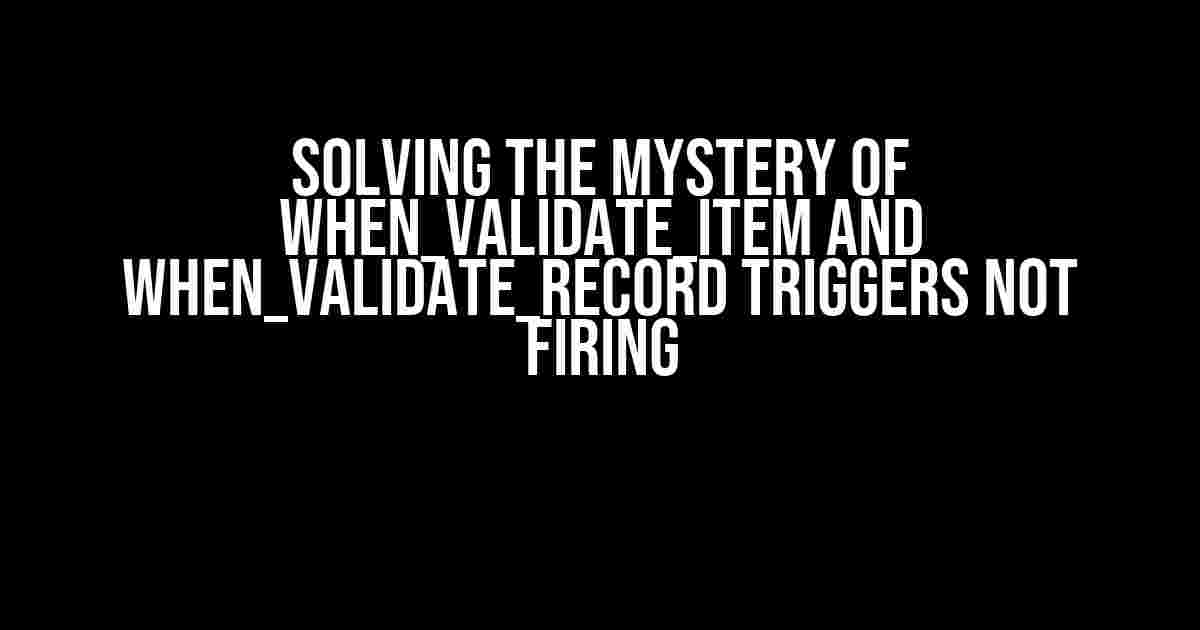Are you experiencing frustration when trying to use the When_validate_item and When_validate_record triggers in your application, only to find that they don’t fire when moving to the next record? You’re not alone! This issue has stumped many developers, but fear not, for we’re about to dive into the depths of this conundrum and emerge with a solution.
Understanding the Triggers
Before we dive into the solution, it’s essential to understand how these triggers work. The When_validate_item and When_validate_record triggers are used to validate data in your application. The When_validate_item trigger is used to validate individual items or fields, whereas the When_validate_record trigger is used to validate the entire record.
When_validate_item Trigger:
The When_validate_item trigger is fired when the user navigates away from an item or when the item is validated programmatically using the VALIDATE_ITEM procedure.When_validate_record Trigger:
The When_validate_record trigger is fired when the user navigates away from the record or when the record is validated programmatically using the VALIDATE_RECORD procedure.The Problem: Triggers Not Firing When Moving to Next Record
The issue at hand arises when you're trying to validate data using the When_validate_item and When_validate_record triggers, but they don't fire when moving to the next record. This can be frustrating, especially if you're relying on these triggers to ensure data integrity.
So, why do these triggers not fire when moving to the next record? The answer lies in the way Oracle Applications handles record navigation.
The Solution: Understanding Oracle Applications' Record Navigation
Oracle Applications uses a mechanism called "buffer management" to manage record navigation. When you move to the next record, the current record is not actually saved or validated; instead, the application simply moves the cursor to the next record in the buffer.
This means that the When_validate_item and When_validate_record triggers are not fired when moving to the next record because the current record is not being validated or saved.
Workaround: Using the Post-Query Trigger
One way to overcome this issue is to use the Post-Query trigger. The Post-Query trigger is fired after the query is executed and the records are fetched from the database.
By using the Post-Query trigger, you can validate the data after the records are fetched, ensuring that the data is validated even when moving to the next record.
Example Code:
BEGIN
IF (:SYSTEM.TRIGGER_COUNT = 1) THEN
-- Validate data here
END IF;
END;In this example, the Post-Query trigger is fired after the query is executed, and the data is validated using the code inside the trigger.
Another Solution: Using a Custom Button
Another approach is to create a custom button that, when clicked, validates the data and then moves to the next record.
This solution requires creating a custom button on the form and assigning a PL/SQL code to it. The PL/SQL code will validate the data and then move to the next record using the NEXT_RECORD procedure.
Example Code:
BEGIN
-- Validate data here
NEXT_RECORD;
END;In this example, the custom button is clicked, validating the data, and then moving to the next record using the NEXT_RECORD procedure.
Best Practices
To avoid issues with the When_validate_item and When_validate_record triggers, follow these best practices:
- Use the Post-Query trigger to validate data after the records are fetched.
- Create custom buttons with PL/SQL code to validate data and move to the next record.
- Avoid relying solely on the When_validate_item and When_validate_record triggers for data validation.
Conclusion
In conclusion, the When_validate_item and When_validate_record triggers not firing when moving to the next record can be a frustrating issue, but by understanding Oracle Applications' record navigation and using the Post-Query trigger or custom buttons, you can overcome this problem and ensure data integrity in your application.
Remember to follow best practices to avoid issues with these triggers and ensure a seamless user experience.
| Solution | Description |
|---|---|
| Post-Query Trigger | Validate data after records are fetched from the database. |
| Custom Button | Validate data and move to the next record using a custom button with PL/SQL code. |
By implementing these solutions and following best practices, you'll be able to overcome the issue of the When_validate_item and When_validate_record triggers not firing when moving to the next record, ensuring a robust and reliable application.
Frequently Asked Question
Got stuck with Oracle Apex triggers? Don't worry, we've got you covered! Here are some frequently asked questions about when_validate_item and when_validate_record trigger not firing when a record moves to the next record.
Q1: Why doesn't the when_validate_item trigger fire when I move to the next record?
The when_validate_item trigger only fires when the item's value is actually changing, not just when the focus moves to the next record. If the item's value remains the same, the trigger won't fire. Make sure the item's value is actually changing when you move to the next record.
Q2: Is it true that when_validate_record only fires when the record is actually changed?
Yes, that's correct! The when_validate_record trigger only fires when the record is actually modified, not just when you move to the next record. If the record remains unchanged, the trigger won't fire.
Q3: Can I use the when-new-record-instance trigger to validate the record instead?
While the when-new-record-instance trigger does fire when you move to a new record, it's not the best choice for validation. This trigger fires before the record is actually created or updated, so you won't have access to the new record values. Stick with when_validate_item or when_validate_record for validation purposes.
Q4: What if I need to validate multiple items on the record? Should I use multiple when_validate_item triggers?
No need to create multiple triggers! You can use a single when_validate_record trigger to validate multiple items on the record. Just make sure to check the relevant item values within the trigger code.
Q5: Can I use JavaScript to force the when_validate_item trigger to fire when I move to the next record?
While it's technically possible to use JavaScript to simulate a change to the item value, it's not recommended. This can lead to unexpected behavior and errors in your application. Instead, focus on designing your triggers to work with the natural flow of your application.


